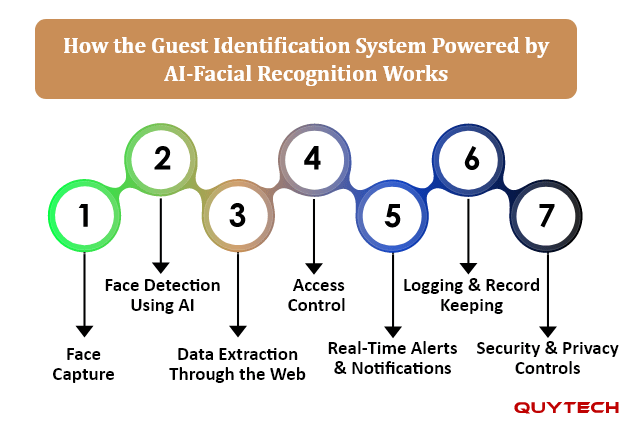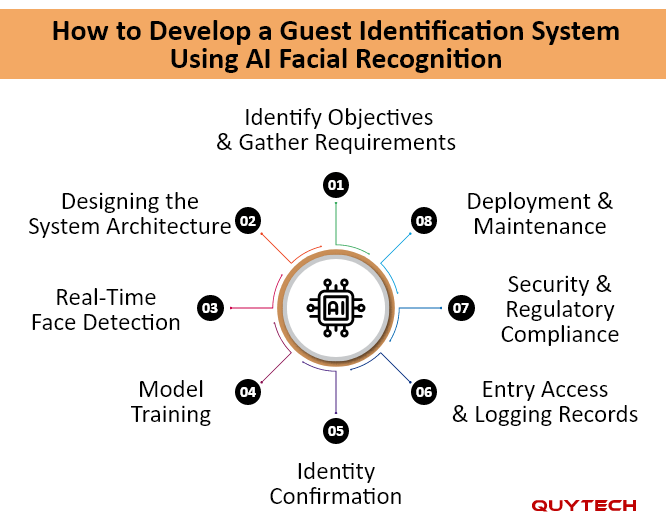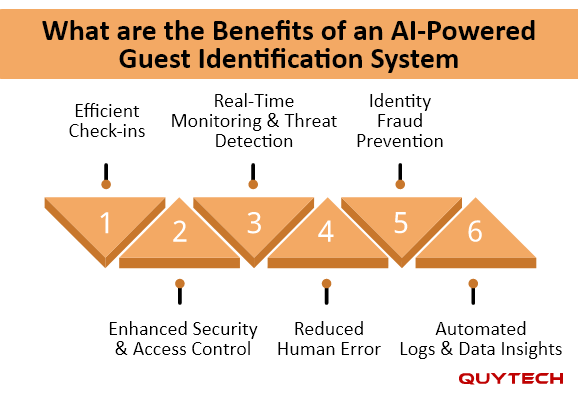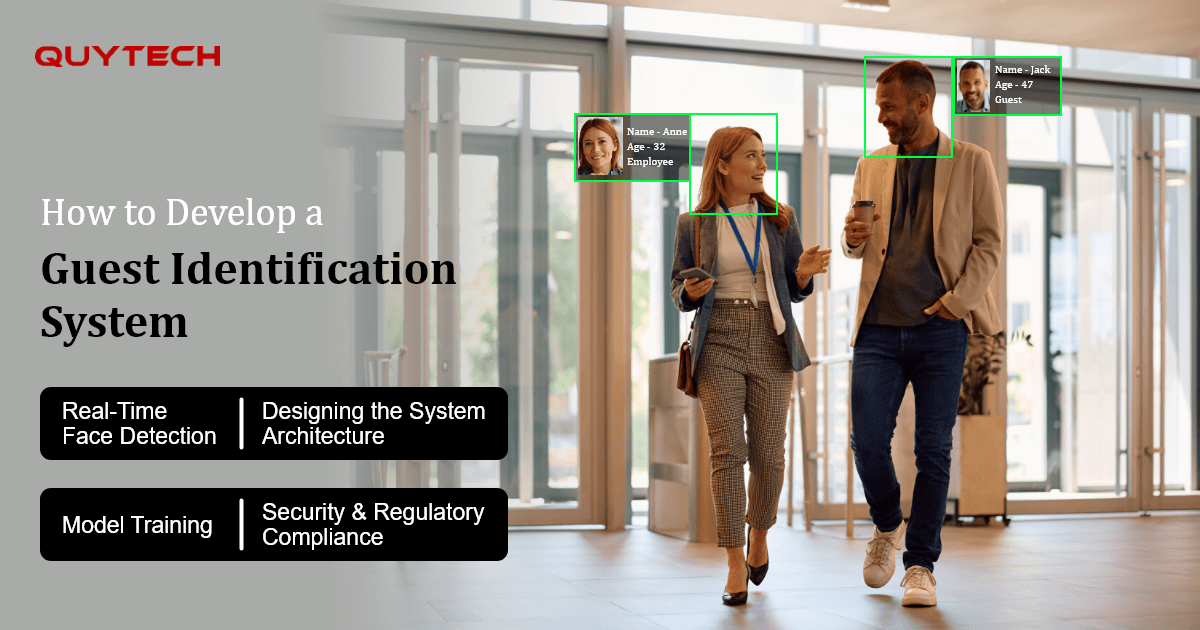Imagine depending on visitor registers to keep a record of the guests at a public event. Long queues of guests are waiting to get entry approvals to the premises. This is what a traditional guest identification system looks like. Being dependent on human operators, it is prone to human error and bias, impacting the security as well as the guests’ experience.
An AI-powered guest identification system eliminates these limitations. It utilizes advanced AI tools and techniques along with anomaly detection systems. With a proactive approach towards guest recognition and security it eliminates human error as well.
In this blog, we will talk about the functional mechanism, benefits, and development process of an AI-based guest identification system and how it exceeds the traditional system.
Facial Recognition and Guest Identification: Market Trends & Stats
- A report by Future Market Insight shows that the global guest management system market is anticipated to rise from USD 1.8 billion in 2025 to USD 6.9 billion by 2035 with a CAGR of 11.7%. The services segment is driving the increase at a CAGR of 13.9%
- By 2025, the web-based segment is expected to hold a 68.3% market share, dominating the worldwide guest management system market.
- Facial recognition is a key element of AI-powered guest identification, considering its rising adoption in security, surveillance, and access control.
- The banks and financial institutions industry is expected to grow at the quickest rate, with a projected CAGR of 12.8% from 2025 to 2035.
What is a Guest Identification System
As the name itself states, a guest identification system is a traditional solution that helps the user in managing records of the guests. It works by verifying identities through capturing the details of the guests, like their names, age, purpose of visit, time-stamping their entry and exit times, etc.
It maintains a record based on this information to enhance security and compliance. The guest identification system captures the data through manual entries, reception verifications, and entry passes. While it records visitor entries, it is often prone to inaccuracy, human error, minimal security, and a time-consuming check-in process. All these inefficiencies give rise to the need for a smart guest identification system.
The Role of AI Facial Recognition in Guest Identification Systems
When integrated with artificial intelligence, the guest identification system becomes equipped with smart features that detect guests in real-time. It utilizes machine learning algorithms and computer vision that help it to identify, analyze, and verify the identity of the guests in seconds. The following pointers highlight the role of AI facial recognition in a guest identification system:
- AI for the guest identification system identifies the guests in seconds with the help of facial recognition.
- It identifies the faces with the help of deep learning models and gathers guest data based on that.
- When backed by artificial intelligence, the guest recognition system eliminates the chances of information being manipulated or entered incorrectly.
- A guest identification system using AI creates logs on entry and exit of the guests, keeping everything controlled and secure.
- Apart from this, the logs, access, and other security-related information can be accessed by the authorized personnel only, improving system security.
Read More: Intelligent Video Monitoring Systems Development: A Complete Guide
How the Guest Identification System Powered by AI-Facial Recognition Works
The following steps describe the functional mechanism of a guest identification system using AI-facial recognition:

1. Face Capture
In the first stage, the camera captures the guests when they enter with the help of the CCTV. It does not need manual entry sign-ins. Computer vision enables real-time capturing in seconds with enhanced accuracy.
2. Face Detection Using AI
AI-enabled deep learning models create faceprints that are created by extracting facial landmarks. With this, the identification process becomes accurate as facial landmarks are different for every individual.
3. Data Extraction Through the Web
Once the facial features are extracted, the system utilizes them to derive the information of the guest through the web. It works by utilizing the NLP models, web crawling, etc, to access information through web-based platforms.
4. Access Control
After deriving the information of the guests, the AI-powered guest identification system sends the information to the authorized personnel. The personnel checks the information and grants or denies entry access to the guest thereafter.
5. Real-Time Alerts and Notifications
The guest identification system using AI uses anomaly detection algorithms. These algorithms detect any possible threat or unusual behaviour and notify the authorized personnel. It sends alerts to the security systems as well to take appropriate actions proactively.
6. Logging and Record Keeping
Guest recognition software keeps a logging record when guests enter and when they exit. These records provide the administration with the required information about the guests. The records are utilized for visitor analytics as well.
7. Security and Privacy Controls
The AI-powered visitor identification system follows the required privacy and security regulations. It restricts access to the guest data to the authorized personnel only, and the data is encrypted for added safety. This ensures that no third party gets access to guest information.
Read More: How to Build AI-Powered Crowd Monitoring Systems? CCTV Security Solution
How to Develop a Guest Identification System Using AI Facial Recognition
The development procedure of a guest identification system using AI requires the following steps to be followed:

Step 1: Identify Objectives and Gather Requirements
The primary steps begin with identifying the function that the system needs to perform. It includes defining the objectives, like guest facial recognition, premise access logs, and security. The key requirements in this step include deciding the position of the camera, integrating the existing system with the guest recognition system, determining the type of data to be collected, etc.
Step 2: Designing the System Architecture
Design the system architecture with the cameras as the input layer, followed by face detection and recognition models for generating facial embeddings. Integrate a secure web server for information derivation along with system logging and entry access by personnel.
Step 3: Real-Time Face Detection
Integrate face detection models and live video processors to detect the guests’ faces in real-time. It generates facial embeddings from the detected faces. The face embeddings generated from these models will be forwarded to the face recognition models.
Step 4: Model Training
Since the guest identification system uses AI for facial recognition, utilizing pre-trained models can be beneficial. It assists the facial capturing and embedding generation processes for accurate and relevant information collection.
Step 5: Identity Confirmation
Utilize similarity metrics to compare the captured facial embeddings to the web server. Setting a percentage benchmark, like a 95% match, will help in enhancing accuracy. It will help in enhancing the accuracy of the matching process. The identity gets confirmed as soon as the match is found.
Step 6: Entry Access and Logging Records
Confirmed identity will be approved for access to the premises by the integrated notifications sent to the personnel. Guests’ detail logs will be managed in a centralized storage system. Prefer a cloud-based platform for storing the data if you want a scalable solution.
Step 7: Security and Regulatory Compliance
Ensure that you comply with the security-related legal regulations like HIPAA, GDPR, etc. Make sure that the data you collect and store is encrypted to prevent third-party interference. Integrate access controls to ensure that only authorized personnel have access to logs and collected data.
Step 8: Deployment and Maintenance
Once you have followed the above steps, the AI-powered guest identification system can be deployed either on-premise or on a cloud platform. Implement monitoring tools to track the performance and deviations. Update the guest identification system whenever required.
Read More: Why AI Facial Recognition System is the Future of Cybersecurity?
What are the Benefits of an AI-Powered Guest Identification System
A guest identification software utilizing AI offers numerous benefits for various industries. The following are some of its key benefits:

Efficient Check-ins
The guest recognition system reduces the time spent on verifying documents and manual check-ins, thanks to its AI facial recognition feature. Guest identification is done within seconds, increasing the efficiency of entry/exit processes.
Enhanced Security and Access Control
AI for guest recognition enhances security as it checks the identity of the guests before granting them premise access. It also improves access control by restricting the security-related data to authorized personnel only. Another feature that contributes to the security is data encryption, which prevents third-party access to your data.
Real-Time Monitoring and Threat Detection
The AI-powered guest recognition utilizes video analytics that help the system monitor the situation in real-time. Apart from this, it also assists in detecting any unusual activity or threats. The system enables real-time notifications and alerts the security personnel when any threat is detected.
Reduced Human Error
With the help of AI models and real-time face detection features, the guest identification system functions seamlessly. The face embedding modules and real-time detectors ensure that the person is identified accurately and fills in their details. This eliminates the chances of human error in entering guest details.
Identity Fraud Prevention
The AI models utilized are accurate to levels that they cannot be deceived with forged identities and impersonations. The guest identification system is trained with large datasets and accuracy levels to enable it to detect even a single flaw and notify the security.
Automated Logs and Data Insights
The time stamping and record keeping are done automatically in the guest identification systems. This eliminates the need for staff to work on recording entries manually and helps in directing their efforts in other areas. It also records the data collected throughout the visits and offers insights like peak visiting hours, average number of visitors, etc.
How Quytech Helps You Develop AI-Powered Guest Identification Systems
Quytech excels in building guest identification solutions utilizing artificial intelligence. Our team of capable developers effectively communicates throughout the development process to ensure that the solution meets your expectations. We emphasize creating scalable and customized solutions that integrate with your existing guest recognition systems seamlessly.
With successful AI-powered CCTV solutions that not only detect unusual activities in real-time but also alert to enable proactive actions, Quytech stands by its promise of quality solutions. We cater a variety of industries be it healthcare or finance, our guest identification solutions blend effortlessly with each.
Conclusion
Traditional guest identification systems are no longer compatible with the current security trends. Manual check-in/ check-out systems are not only prone to human error but are also time-consuming. Switching to AI-powered guest recognition systems is the change that is much needed.
It works by utilizing computer vision to detect and analyze facial features and identify the guest by deriving data from the web. With benefits like quick check-ins, better security, threat detection, and reduced human error, the AI-based guest identification system marks a step into the future.
FAQs
Yes, when you partner with a reliable service provider, they ensure that the developed system follows all the required legal regulations
Yes, the guest identification system using AI facial recognition easily identifies the guests even in low-light or crowded areas. The accuracy remains impeccable
Not necessarily, AI guest identification systems do not require an existing database to function. They can work by connecting to web-based servers and deriving guest information from them
Yes, the guest identification systems using AI facial recognition can be integrated with the existing security systems. It can be used to restrict access to authorized personnel, enhancing safety.



